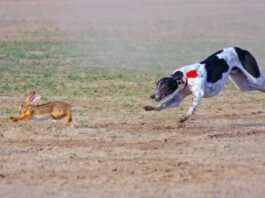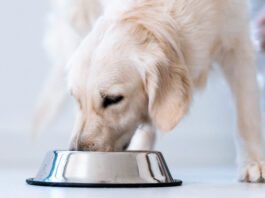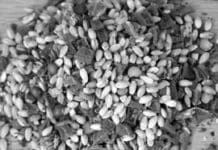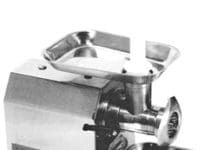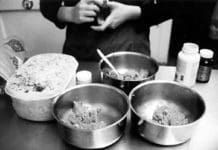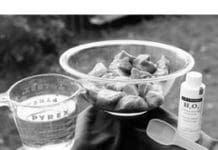Semi-Homemade Dog Food
We frequently write about kibble and canned dog food, but have neglected some of the less common (but no less worthy) types of commercial foods. Here’s a look at commercial products that make it easy to feed a home-prepared diet. In our reviews of dry and canned foods, we make specific recommendations for selecting products for your dog. We’re not going to do this here; instead, we simply want to inform you about these alternatives to conventional kibble and canned food, and describe the differences between them.
Best Food Grinders Used For Home-Prepared Dog Food Diets
People who are interested in feeding a home-prepared diet to their dogs often delay the transition as they grapple with various concerns. Frequently, they have come to believe the claims that a home-prepared diet offers dogs superior nutrition and can result in increased health and vigor . . . but they are still beset by fears that their dogs will suffer a broken tooth or perforated intestines caused by eating raw bone fragments.
The Evolution of the Raw Dog Food Diet
Canines have eaten raw for a whole lot longer than they've eaten cooked foods! It's difficult for us to understand, in the face of this one fact, how any dog guardians (much less thousands of veterinarians) could deny that raw food diets are healthful for dogs. But is it really best for ALL dogs? Actually, there are exceptions.
More On Frozen Foods!
50808
Frozen Raw Meat-Based Dog Food Diets
There are thousands of dog guardians who feed their dogs homemade BARF-based diets, buying all the ingredients and preparing their dogs’ meals from scratch. People who utilize home-prepared diets are happy to discuss the many benefits of this feeding method for their dogs, including clean, tartar-free teeth; fresh breath; strong bones, muscles, and joints; a glossy coat; a healthy amount of energy and a balanced temperament; and overall vibrant good health. For all the people who have made the leap to a homemade, meat-based diet for their dogs, however, there are many more who would like to make the change, but who are intimidated by the challenge of “getting it just right.” Some are afraid of failing to present their dogs with a balanced array of nutrients; others fear bacterial contamination from handling raw meats.
The Nutritional Adequacy of Raw Food Diets
Research is needed to analyze the nutritional adequacy of raw food diets. However, a published study didn’t accomplish that goal. The Journal of the American Veterinary Medical Association (JAVMA) published an article written by two veterinarians about homemade and commercially made raw meat-based diets. (A similar article, based on the same data, was published in the AKC Gazette.) The article has been regarded by many proponents of homemade diets as a warning shot fired by the commercial-food -producing community and their traditional veterinary medical footsoldiers over the bow of the raw feeding ship.
Comparing the Best Raw Dog Food Diet Plans
Have you ever noticed that dog owners tend to select one canine expert to follow in the area of dog nutrition and dog food and then another expert for training? And they’ll often adhere to their personal guru’s program no matter what? Is it our unconscious dog-like loyalty, or what? Many of our readers are already preparing their own dog food, and generally, they are following the guidelines of some canine nutrition expert. However, many more of our readers have not yet sorted out the differences between the raw dog food diets being promoted today.
Feeding Your Dog a Raw Diet
For thousands of years, Mother Nature has fed her dogs and cats raw food. Their wild cousins continue to dine on freshly captured prey, but most American dogs and cats eat commercial pet foods from cans and packages or home-cooked grains and meats. The result, say a number of veterinarians and nutritionists, is deteriorating health in our canine companions. In response is a growing trend toward home-prepared diets for our dogs, away from cooked food and toward more natural fare.
Raw Meat-Based Dog Food Diets
There are some very high-profile illnesses that can result from handling raw meat – scarifying things like E. coli, salmonella, and trichinella. The mere idea of these threats prevents many people interested in “raw feeding” from giving this type of highly beneficial diet a try. So, we’re going to demystify everything that could go wrong with raw meat (but probably won’t). We’ll describe some horrible diseases, and how they would affect a person who got them, and how they would affect a dog.
When Feeding a Raw Diet Use Safe Meat Handling Practices
One of the greatest concerns many people have about switching their dogs to a raw diet is the fear of bacterial infection, either in themselves or their pets. News reports of people dying from E. coli and salmonella poisoning have no doubt fanned the flames of that fear. But most people who have successfully transitioned their dogs to a raw diet report no problems are delighted with their dogs’ health and appearance. The secret, advocates say, is in good food handling practices. Dog owners who neglect safe handling techniques are certainly more at risk of infection from any pathogens (a list of the usual suspects is discussed in great detail in “What Evil Lurks Within,” page 9) that happen to be present in raw meat. This is especially true of children, whose immune systems are immature and inexperienced, and people with compromised immune systems. But keeping your meat safe and your kitchen clean is not exactly rocket science, folks! Anyone can learn to do it.
Benefits of BARF Raw Food Diet
Recently, I had the great fortune to meet Dr. Ian Billinghurst, who may be described as the modern father of the “bones and raw food” diet for dogs. Dr. Billinghurst was kind enough to take time away from a vacation in San Francisco to talk over lunch. I had a lot of questions for the Australian veterinarian, given that I had just finished editing the article about feeding bones that appears on the previous pages. Dr. Billinghurst was patient, helpful, and full of encouragement for me and all other dog owners who are “sitting on the fence” of the bones issue.
Raw Food Diet Does the Trick
When Deanna Cuchiaro of Whitehouse Station, New Jersey, set out to adopt an Irish Setter, she had no idea the rescue would change her entire perspective on animal health care. Cuchiaro already had one Irish Setter, Brandy, who had recently turned 10, and she wanted to get another so that Brandy could help pass his positive influence around the house to the newcomer. She considered getting a puppy, but decided to adopt a rescue dog from the Irish Setter Club of Central Connecticut rescue program. She met representatives of the rescue group at a local Irish Setter show who told her there was a large two-year-old male Setter available for adoption.




